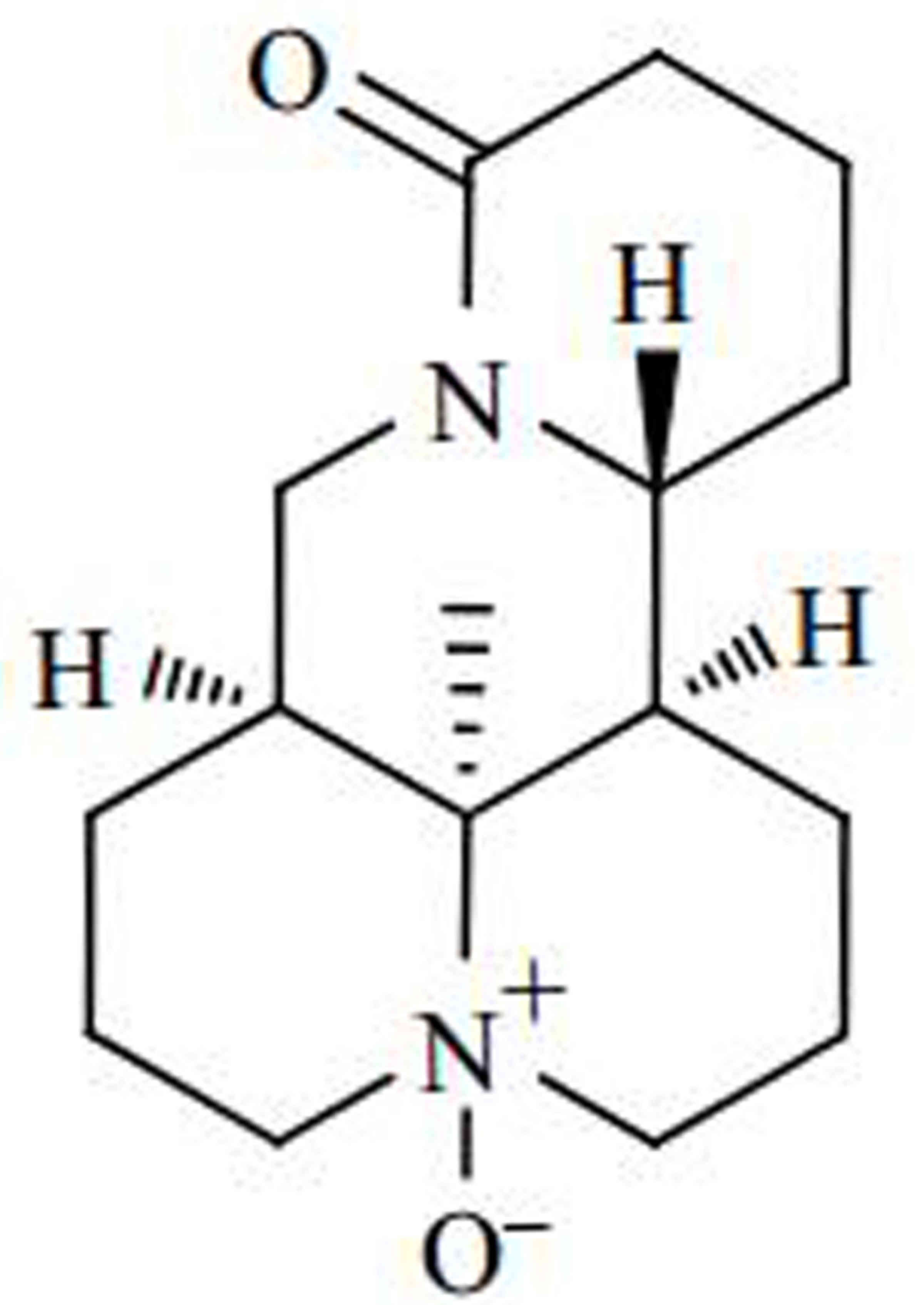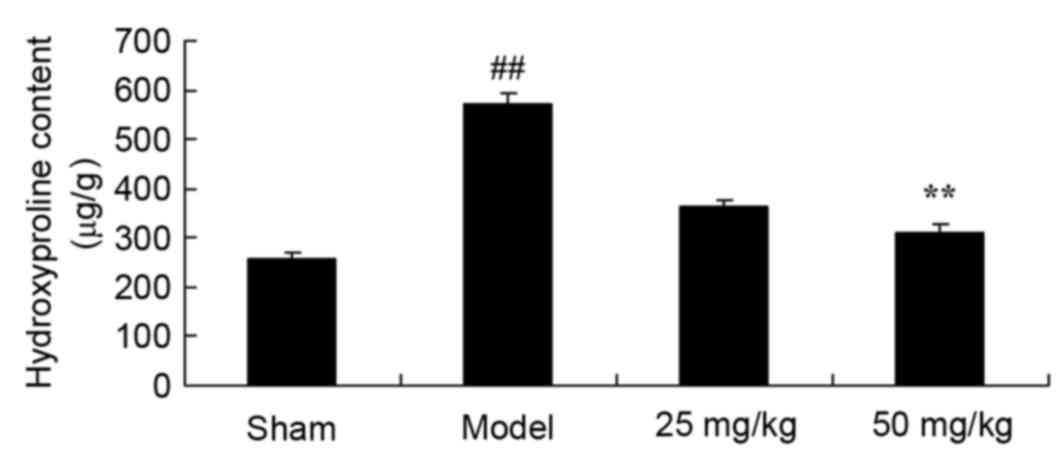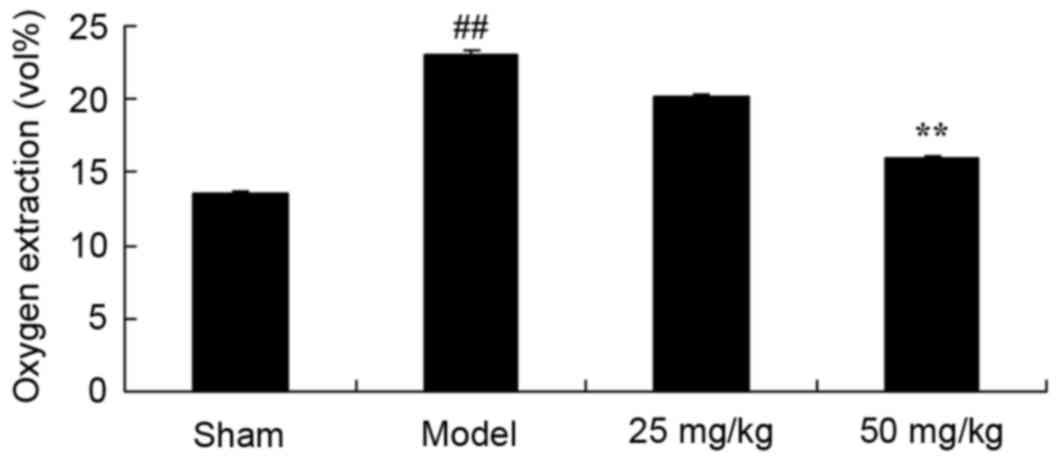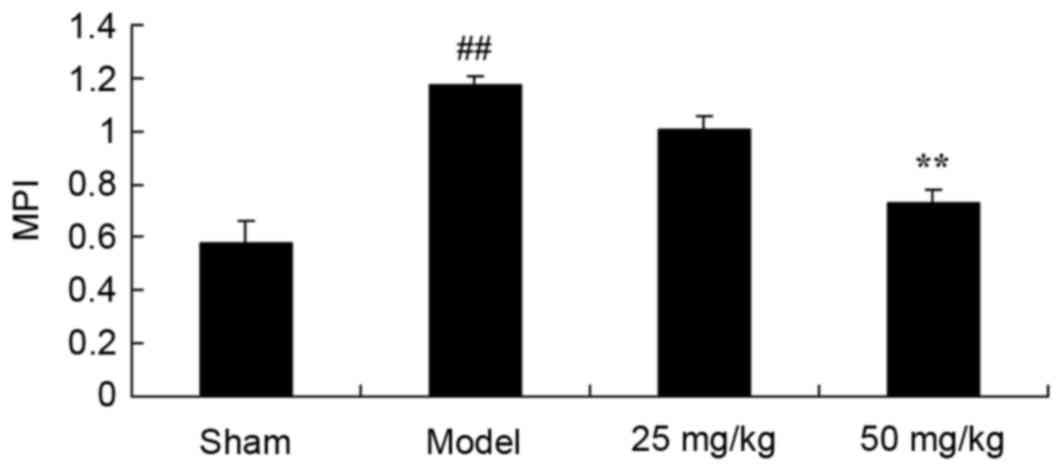Oxymatrine protects against the effects of cardiopulmonary resuscitation via modulation of the TGF-β1/Smad3 signaling pathway
- Authors:
- Published online on: January 4, 2018 https://doi.org/10.3892/mmr.2018.8373
- Pages: 4747-4752
Abstract
Introduction
Complete global brain ischemia and reperfusion injury triggered by cardiac arrest (CA) are fundamental causes of the reduced survival rates for patients with anabiosis following CA (1). As brain tissues have a low tolerance to hypoxic ischemia and its adverse reactions to ischemia reperfusion, cerebral protection following cardiopulmonary resuscitation (CPR) is difficult to treat (2). Complex mechanisms are responsible for the cerebral lesions caused by CA/CPR, including free radical formation, calcium overload, integrated enzyme reactions and the activation of death signaling pathways (3). This subsequently leads to apoptosis and necrosis of neurons. Previous clinical research and trials have demonstrated that therapeutic hypothermia greatly increases defibrillation success rates, ameliorates neural function and survival, and improves overall prognosis (4). However, the optimal opportunity and temperature range in which to conduct this therapy is difficult to obtain; it is generally understood that therapeutic hypothermia should be induced rapidly and at a low temperature during CPR following sudden cardiac arrest (5).
A previous study have indicated that the expression levels of transforming growth factor-β1 (TGF-β1) are increased following cerebral ischemia, suggesting that TGF-β1 is associated with the restoration and survival of neurons (6). However, certain exogenous intravenous and local intracerebral injections of TGF-β1 may facilitate the development of neurological impairment syndromes following cerebral ischemia, and reduce infarction volumes and encephaledema. It is understood that TGF-β1 is a multi-functional cytokine that is involved in various pathological and physiological procedures, stimulates secretion of the extra-cellular matrix and promotes angiogenesis (7). Furthermore, it exhibits anti-inflammatory, chemotaxis, movement-associated and anti-proliferative properties, and serves an essential role in repairing injured vessels (8).
A previous study indicated that, following activation of the TGF-β1 receptor, signal transduction is primarily mediated by phosphorylation of plasmosin; a member of the mothers against decapentaplegic (Smad) protein family (9). Once combined with Smad4, activated and phosphorylated Smad2 and 3 proteins facilitate the transport of TGF-β1 to the cell nucleus, thus promoting its biological effects (9).
As an alkaloid extracted from the kuh-seng compound, oxymatrine demonstrates anti-inflammatory and anti-oxidative stress properties, and has become an essential drug for the treatment of tumors and hepatic fibrosis (10,11). Studies involving diabetic rats have demonstrated that oxymatrine improves cognitive impairment, reduces oxidative stress levels and increases the expression levels of antioxidative factors, such as superoxide dismutase (SOD) and glutathione (11). In addition, oxymatrine may significantly reduce the expression levels of nuclear factor (NF)-κB, tumor necrosis factor-α, interleukin (IL)-1β and caspase-3 (12). Following administration of oxymatrine, the expression levels of melanoma differentiation-associated protein, alanine transaminase, arginine succinyltransferase, thyroglobulin, IL-6 and NF-κB were markedly decreased, while the expression levels of SOD were increased (13). The aim of the present study was to examine the protective effects of oxymatrine against CPR, as well as the potential underlying mechanisms of oxymatrine in cardiac fibrosis.
Materials and methods
Animal experiments
Animal experiments were approved by the University Laboratory Animal Research Committee of The First Hospital of Jilin University (Changchun, China). A total of 32 adult Sprague-Dawley (SD) rats (weight, 250±30 g) were purchased from the Qinghai Experimental Animal Center (Zhejiang, China) and maintained in a specific pathogen-free environment (22–24°C, 55–60% humidity, 12 h light/dark cycle and free access to food and water). Rats were anaesthetized by intraperitoneal injection of chloral hydrate (300 mg/kg, intraperitoneal, Sigma-Aldrich; Merck KGaA, Darmstadt, Germany) and a CPR model was established by asphyxiation. To do this, the tracheal intubation was closed at the end of expiration for 5 min. SD rats were randomly divided into sham-operated (n=6), model (n=10), 25 mg/kg oxymatrine-treated (n=8) and 50 mg/kg oxymatrine-treated (n=8) groups. In the 25 and 50 mg/kg oxymatrine groups, SD rats were administered with 25 and 50 mg/kg oxymatrine (Intragastrically) once a day for 4 weeks, respectively. In sham-operated and model groups, rats were anaesthetized by intraperitoneal injection of chloral hydrate without the CPR model, and administered with normal saline once a day for 4 weeks (Intragastrically). Oxymatrine (purity, >95%) was purchased from Shanghai Leiyunshang Green Valley Pharmaceutical Co., Ltd. (Xi'an, China). Its structural formula is presented in Fig. 1.
Enzyme-linked immunosorbent assay (ELISA) analysis of troponin I concentration and ejection fraction
After treatment with oxymatrine, rat was anaesthetized and peripheral blood was acquired from caudal vein. Serum was separated after centrifugation at 1,000 × g for 10 min at 4°C to measure troponin I concentrations using an ELISA kit (cat. no. 2010–2-HSP; Life Diagnostics, Inc., West Chester, PA, USA) according to the manufacturer's protocol. The absorbance value was detected at a wavelength of 450 nm.
The percentage ejection fraction (EF) was calculated using the same area-length method described previously (14). Lactate levels (cat no. M002; Nanjing Jiancheng Bioengineering Institute, Nanjing, China) were determined from 0.3-ml samples at baseline. A partial pressure of oxygen (PaO2) value of <5 mmHg was considered to indicate hypoxia, and a PaO2 value of between 100 and 300 mmHg was considered to indicate mild hyperoxia. The myocardial performance index (MPI) was calculated as (a-b)/b, where a=mitral valve closure-to-opening interval and b=left ventricular ejection time. Oxygen extraction was calculated as the difference between the arterial (Ca) and venous concentrations (Cv) of oxygen (CaO2-CvO2). Therefore, CaO2 = 1.38 × hemoglobin (HB) × arterial oxygen saturation + PaO2 × 0.0031; CvO2 = 1.38 × HB × mixed venous oxygen saturation + mixed venous oxygen tension (PvO2) × 0.0031.
Hydroxyproline content assessment
The hydroxyproline content of heart tissues was assessed following a previously described method (13) using ELISA kits (cat no. A030-2; Nanjing Jiancheng Bioengineering Institute) according to the manufacturer's protocol. The absorbance value was detected at a wavelength of 450 nm.
Western blot analysis
Heart tissue samples were homogenized using 10 µg/ml radioimmunoprecipitation buffer and protease inhibitors (EMD Millipore, Billerica, MA, USA). The supernatant was collected and total protein was quantified using a bicinchoninic acid assay (Beyotime Institute of Biotechnology, Shanghai, China). Total protein (50 µg) was separated by 12% SDS-PAGE and transferred onto nitrocellulose membranes. Following blocking with 5% nonfat milk in Tris-buffered saline with 0.1% Tween-20, membranes were incubated with the following primary antibodies at 4°C overnight: Anti-TGF-β1 (cat no. sc-7892, dilution, 1:4,000; Santa Cruz Biotechnology, Inc), anti-TGF-β receptor type 1 (TβR1; cat no. 3712, dilution, 1:3,000; Cell Signaling Technology, Inc.), anti-Smad3 (cat no. sc-8332, dilution, 1:4,000; Santa Cruz Biotechnology, Inc) and anti-β-actin (cat no. sc-7210, dilution, 1:2,000; Santa Cruz Biotechnology, Inc). This was followed by incubation with secondary antibodies (dilution, 1:5,000, cat no. sc-2030; Santa Cruz Biotechnology, Inc.) for 1 h at room temperature. Densitometry was detected using Beyo enhanced chemiluminescence Plus (Beyotime Institute of Biotechnology) and performed using ImageJ software version 1.47 (National Institutes of Health, Bethesda, MD, USA).
Statistical analysis
Data are expressed as the mean ± standard error and SPSS software version 17.0 (SPSS, Inc., Chicago, IL, USA) was used. Student's t-test were used to analyze the differences between groups. P<0.05 was considered to indicate a statistically significance difference.
Results
Oxymatrine treatment reduces troponin I levels and EF in a rat model of CPR
The present study investigated whether oxymatrine may protect against an increase in troponin I levels and EF in a rat model of CPR. The levels of troponin I and the percentage EF of rats in the model group were significantly increased when compared with the sham-operated group (Fig. 2). However, treatment with 50 mg/kg oxymatrine significantly reduced troponin I levels and the EF percentage when compared with the model group (Fig. 2).
Oxymatrine treatment protects against increases in heart hydroxyproline content in a rat model of CPR
At 4 weeks following induction of the rat CPR model, hydroxyproline content was significantly increased in the model group when compared with the sham group (Fig. 3). Following administration of 50 mg/kg oxymatrine, hydroxyproline content was significantly ameliorated when compared with the model group (Fig. 3).
Oxymatrine treatment protects against increased PaO2 levels and decreased lactate levels in a rat model of CPR
Following induction of the CPR model, PaO2 levels were significantly decreased, while lactate levels were significantly decreased in the CPR model group when compared with the sham group (Fig. 4). Following treatment with 50 mg/kg oxymatrine, PaO2 levels decreased and lactate levels increased when compared with the model group (Fig. 4).
Oxymatrine treatment protects against increased oxygen extraction in a rat model of CPR
In order to evaluate whether oxymatrine protects against increased oxygen extraction in a rat model of CPR, the level of oxygen extraction was compared among all experimental groups. A significant increase in oxygen extraction was observed in the model group when compared with the sham group (Fig. 5). By contrast, 50 mg/kg oxymatrine administration significantly reduced oxygen extraction when compared with the model group (Fig. 5).
Oxymatrine treatment protects against increased MPI in a rat model of CPR
The present study investigated whether oxymatrine may protect against increases in MPI in the rat model of CPR. The MPI of model rats was significantly increased when compared with the sham group (Fig. 6). By contrast, continuous administration of 50 mg/kg oxymatrine for 4 weeks, was associated with a significant reduction in MPI when compared with the model group (Fig. 6).
Oxymatrine treatment reduces the protein expression levels of TGF-β1 in a rat model of CPR
A total of 4 weeks following CPR model induction, TGF-β1 protein expression levels were increased significantly in the model group when compared with the sham group (Fig. 7). By contrast, following 4 weeks of treatment with 50 mg/kg oxymatrine, TGF-β1 protein expression levels were significantly suppressed when compared with the model group (Fig. 7).
Oxymatrine treatment reduces the protein expression levels of TβR1 in a rat model of CPR
Representative western blot images are presented in Fig. 8A. Compared with the sham group, CPR significantly induced TβR1 protein expression levels (Fig. 8). By contrast, treatment with 50 mg/kg oxymatrine significantly reduced TβR1 protein expression levels when compared with the model group (Fig. 8).
Oxymatrine treatment reduces the protein expression levels of Smad3 in a rat model of CPR
Representative western blot images are presented in Fig. 9A. Compared with the sham group, CPR significantly induced Smad3 protein expression levels (Fig. 9). However, treatment with 50 mg/kg oxymatrine significantly reduced Smad3 protein levels when compared with the model group (Fig. 9).
Discussion
CA is a primary cause of mortality and severe disability worldwide. Recovery of cerebral function is a complex issue during CPR (15). Reperfusion following cerebral ischemia may trigger serious cerebral anoxia, resulting in dysneuria (5). The present study demonstrated that oxymatrine significantly inhibited troponin I levels, EF and hydroxyproline content in a rat model of CPR.
CPR may lead to severe hypoxic-ischemic states. Once circulation has halted for 4–6 min, irreversible nerve injury may occur (16). Even if resuscitation is successful, numerous oxygen radicals may induce oxidative stress, thus provoking ischemia reperfusion injuries (16). A previous study revealed that oxidative stress injury is a key underlying mechanism of cerebral injury following CPR, and oxygen extraction assessment demonstrates the oxygen-intake capability of brain tissues and is a key indicator of hypoxic-ischemic encephalopathy (17). The present study demonstrated that oxymatrine significantly reduced PaO2, increased lactate levels, decreased oxygen extraction and reduced the MPI of CPR model rats. Shen et al (13) indicated that oxymatrine protects against myocardial fibrosis via the TGF-β1-Smad signaling pathway.
A previous study indicated that expression levels of Smad3 increase during the early stages of cerebral ischemia (18). Smad3 is involved in a series of pathophysiological alterations, including the increase of cerebral microvessel permeability, aseptic inflammation, blood-brain barrier damage and encephaledema (19). Synthetic Smad3 inhibitors may inhibit these alterations to some extent (20). The present study demonstrated that oxymatrine significantly reduced Smad3 protein levels when compared with the model group.
The TGF subfamily includes TGF-β1, activin and bone morphogenetic protein, which possess various functions associated with cell growth and differentiation (6). TGF-β1 is a multi-functional cytokine (6). Almost all cell types, including epithelial, endothelial and nerve cells, as well as connective tissues, may interact with TGF-β1 and express the corresponding receptors (21). TGF-β1 is involved in cell proliferation and differentiation, embryonic development, extracellular matrix synthesis and angiogenesis (8). It serves an essential role in pathological processes involved in fibrosis, DNA damage repair and tumor growth. TGF-β1 possesses neuroprotective functions in various cerebral injuries, including hypoxia-ischemia, glutamate excitotoxicity, amyloid-β protein accumulation, oxidative stress and human immunodeficiency virus infection (22). Accordingly, the results of the present study indicated that oxymatrine significantly suppressed Smad3 protein expression levels in a rat model of CPR. Fan et al (23) reported that oxymatrine inhibits collagen synthesis via Smad3-mediated induction of the TGF-β1 signaling pathway.
The TGF-β1/TβR1 signaling pathway is pleiotropic and serves fundamental roles in tissue repair, the accumulation of the extracellular matrix, excessive fibrosis and the proliferation and metastasis of tumors (24). TGF-β1 transduces signals via the transmembrane receptor complex together with serine and threonine enzymes (25). As a signaling molecule in cytoplasm, TβR1 directly transduces TGF-β1 signals into the cell nucleus via the cytomembrane. A previous study suggested that TGF-β1/TβR1 may be closely associated with the regulation of inflammation, and activation of the TGF-β1/Smad3 signaling pathway may be pro- or anti-inflammatory (26). In the present study, oxymatrine significantly suppressed TGF-β1/TβR1 protein expression levels in a rat model of CPR. Guo et al (27) indicated that oxymatrine protects against diabetic nephropathy via TGF-β1, and Fan et al (23) reported that oxymatrine inhibits collagen synthesis via the Smad3-induced TGF-β1 signaling pathway.
In conclusion, the results of the present study demonstrated that oxymatrine markedly reduced troponin I levels, EF, hydroxyproline content, PaO2, oxygen extraction and MPI, and increased lactate levels in a rat model of CPR, which may be associated with suppression of reduction the TGF-β1/TβR1/Smad3 signaling pathway. In further study, more in depth signaling pathway analysis and the underlying mechanism of oxymatrine will be explored. The results of this research suggested that oxymatrine treatment may protect against the effects of CPR via regulation of the TGF-β1/Smad3 signaling pathway and may be a novel drug for CPR in a clinical setting.
Acknowledgements
The present study was supported by the Natural Science Foundation of China (grant no. 81471830).
References
|
Takahashi K, Sasanuma N, Itani Y, Tanaka T, Domen K, Masuyama T, Ohyanagi M and Suzuki K: Impact of early interventions by a cardiac rehabilitation team on the social rehabilitation of patients resuscitated from cardiogenic out-of-hospital cardiopulmonary arrest. Intern Med. 54:133–139. 2015. View Article : Google Scholar : PubMed/NCBI | |
|
Blomberg H, Gedeborg R, Berglund L, Karlsten R and Johansson J: Poor chest compression quality with mechanical compressions in simulated CPR: A randomized, cross-over manikin study. Resuscitation. 82:1332–1337. 2011. View Article : Google Scholar : PubMed/NCBI | |
|
Chung TN, Kim SW, You JS, Cho YS, Chung SP, Park I and Kim SH: The specific effect of metronome guidance on the quality of one-person CPR and rescuer fatigue. J Emerg Med. 43:1049–1054. 2012. View Article : Google Scholar : PubMed/NCBI | |
|
Ducros L, Vicaut E, Soleil C, Le Guen M, Gueye P, Poussant T, Mebazaa A, Payen D and Plaisance P: Effect of the addition of vasopressin or vasopressin plus nitroglycerin to epinephrine on arterial blood pressure during CPR in humans. J Emerg Med. 41:453–459. 2011. View Article : Google Scholar : PubMed/NCBI | |
|
Jones CM, Thorne CJ, Colter PS, Macrae A, Brown GA and Hulme J: Rescuers may vary their side of approach to a casualty without impact on cardiopulmonary resuscitation performance. Emerg Med J. 30:74–75. 2013. View Article : Google Scholar : PubMed/NCBI | |
|
Maitra SR, Bhaduri S, El-Maghrabi MR and Shapiro MJ: Inhibition of matrix metalloproteinase on hepatic transforming growth factor beta1 and caspase-3 activation in hemorrhage. Acad Emerg Med. 12:797–803. 2005. View Article : Google Scholar : PubMed/NCBI | |
|
Wang X, Qu X, Zhong Q, Li Q and Wang D: Expression of transforming growth factor beta 1 in lung tissue during cardiopulmonary bypass-induced lung injury in dogs. Thorac Cardiovasc Surg. 61:747–753. 2013. View Article : Google Scholar : PubMed/NCBI | |
|
Hutcheson JD, Ryzhova LM, Setola V and Merryman WD: 5-HT(2B) antagonism arrests non-canonical TGF-β1-induced valvular myofibroblast differentiation. J Mol Cell Cardiol. 53:707–714. 2012. View Article : Google Scholar : PubMed/NCBI | |
|
Liu XN, Wang S, Yang Q, Wang YJ, Chen DX and Zhu XX: ESC reverses epithelial mesenchymal transition induced by transforming growth factor-β via inhibition of Smad signal pathway in HepG2 liver cancer cells. Cancer Cell Int. 15:1142015. View Article : Google Scholar : PubMed/NCBI | |
|
He M, Wu Y, Wang M, Chen W, Yuan W and Jiang J: The clinical value of oxymatrine in preventing lamivudine induced YMDD mutation: A Meta-analysis. Evid Based Complement Alternat Med. 2015:9716162015. View Article : Google Scholar : PubMed/NCBI | |
|
Jiang G, Liu X, Wang M, Chen H, Chen Z and Qiu T: Oxymatrine ameliorates renal ischemia-reperfusion injury from oxidative stress through Nrf2/HO-1 pathway. Acta Cir Bras. 30:422–429. 2015. View Article : Google Scholar : PubMed/NCBI | |
|
Zhang Y, Yan R and Hu Y: Oxymatrine inhibits lipopolysaccharide-induced inflammation by down-regulating Toll-like receptor 4/nuclear factor-kappa B in macrophages. Can J Physiol Pharmacol. 93:253–260. 2015. View Article : Google Scholar : PubMed/NCBI | |
|
Shen XC, Yang YP, Xiao TT, Peng J and Liu XD: Protective effect of oxymatrine on myocardial fibrosis induced by acute myocardial infarction in rats involved in TGF-β1-Smads signal pathway. J Asian Nat Prod Res. 13:215–224. 2011. View Article : Google Scholar : PubMed/NCBI | |
|
Ye S, Weng Y, Sun S, Chen W, Wu X, Li Z, Weil MH and Tang W: Comparison of the durations of mild therapeutic hypothermia on outcome after CPR in the rat. Circulation. 125:123–129. 2012. View Article : Google Scholar : PubMed/NCBI | |
|
Edelson DP, Call SL, Yuen TC and Vanden Hoek TL: The impact of a step stool on CPR: A cross-over mannequin study. Resuscitation. 83:874–878. 2012. View Article : Google Scholar : PubMed/NCBI | |
|
Zhao S, Qian J, Wang J, Tang G, Zhengfei Y, Jena C, Xiaobo WU, Neil D, Caijing L and Wanchun T: Effects of oxygen concentrations on postresuscitation myocardial oxidative stress and myocardial function in a rat model of Cardiopulmonary Resuscitation. Crit Care Med. 43:e560–e566. 2015. View Article : Google Scholar : PubMed/NCBI | |
|
Kruzliak P, Pechanova O and Kara T: New perspectives of nitric oxide donors in cardiac arrest and CPR treatment. Heart Fail Rev. 19:383–390. 2014. View Article : Google Scholar : PubMed/NCBI | |
|
Xue M, McKelvey K, Shen K, Minhas N, March L, Park SY and Jackson CJ: Endogenous MMP-9 and not MMP-2 promotes rheumatoid synovial fibroblast survival, inflammation and cartilage degradation. Rheumatology (Oxford). 53:2270–2279. 2014. View Article : Google Scholar : PubMed/NCBI | |
|
Kim BJ, Hur JW, Park JS, Kim JH, Kwon TH, Park YK and Moon HJ: Expression of matrix metalloproteinase-2 and −9 in human ligamentum flavum cells treated with tumor necrosis factor-α and interleukin-1β. J Neurosurg Spine. 24:428–435. 2016. View Article : Google Scholar : PubMed/NCBI | |
|
Stan MS, Sima C, Cinteza LO and Dinischiotu A: Silicon-based quantum dots induce inflammation in human lung cells and disrupt extracellular matrix homeostasis. FEBS J. 282:2914–2929. 2015. View Article : Google Scholar : PubMed/NCBI | |
|
Tuuminen R, Nykänen AI, Krebs R, Soronen J, Pajusola K, Keränen MA, Koskinen PK, Alitalo K and Lemström KB: PDGF-A, -C, and -D but not PDGF-B increase TGF-beta1 and chronic rejection in rat cardiac allografts. Arterioscler Thromb Vasc Biol. 29:691–698. 2009. View Article : Google Scholar : PubMed/NCBI | |
|
Wang J, Yu J, Ding CP, Han SP, Zeng XY and Wang JY: Transforming growth factor-beta in the red nucleus plays antinociceptive effect under physiological and pathological pain conditions. Neuroscience. 291:37–45. 2015. View Article : Google Scholar : PubMed/NCBI | |
|
Fan DL, Zhao WJ, Wang YX, Han SY and Guo S: Oxymatrine inhibits collagen synthesis in keloid fibroblasts via inhibition of transforming growth factor-β1/Smad signaling pathway. Int J Dermatol. 51:463–472. 2012. View Article : Google Scholar : PubMed/NCBI | |
|
Yan X, Liao H, Cheng M, Shi X, Lin X, Feng XH and Chen YG: Smad7 Protein Interacts with Receptor-regulated Smads (R-Smads) to inhibit transforming growth factor-β (TGF-β)/Smad signaling. J Biol Chem. 291:382–392. 2016. View Article : Google Scholar : PubMed/NCBI | |
|
Du S, Li H, Cui Y, Yang L, Wu J, Huang H, Chen Y, Huang W, Zhang R, Yang J, et al: Houttuynia cordata inhibits lipopolysaccharide-induced rapid pulmonary fibrosis by up-regulating IFN-γ and inhibiting the TGF-β1/Smad pathway. Int Immunopharmacol. 13:331–340. 2012. View Article : Google Scholar : PubMed/NCBI | |
|
Xu Z, Ramachandran S, Gunasekaran M, Zhou F, Trulock E, Kreisel D, Hachem R and Mohanakumar T: MicroRNA-144 dysregulates the transforming growth factor-β signaling cascade and contributes to the development of bronchiolitis obliterans syndrome after human lung transplantation. J Heart Lung Transplant. 34:1154–1162. 2015. View Article : Google Scholar : PubMed/NCBI | |
|
Guo C, Han F, Zhang C, Xiao W and Yang Z: Protective effects of oxymatrine on experimental diabetic nephropathy. Planta Med. 80:269–276. 2014. View Article : Google Scholar : PubMed/NCBI |


















